|
Route 66 Side TripCity 66 & E. St. Louis |
|
|
Route 66 Side TripCity 66 & E. St. Louis |
|
|
It was a pleasant quiet Sunday morning when I got to tour old City 66. I was lucky to have two great guides on this journey, Emily Priddy and Ron Warnick of the Friends of the Mother Road. I'm eternally grateful that they were doing the driving because I'm afraid I'd still be lost somewhere in the depths of East St. Louis if I'd driven. The old alignments of Route 66 here can be pretty confusing, in fact I think St. Louis is the most difficult city along Route 66 to trace the old route. City 66 originally left Mitchell past the Chain of Rocks Road and continued south into Granite City on today's Illinois 203. Until just recently one could cross over into St. Louis from here on the McKinley Bridge. It is now closed due to some concerns about its structural integrity. Granite City was quiet and the streets were empty this Sunday morning making our tour all the more enjoyable because we didn't have to contend with traffic. Old buildings, restaurants and stores dating back to the first part of the 20th century and the early days of Route 66 were all around us. | |||
| As we traveled down the old alignment of City 66 in Granite City I spied on old jewelry store sign, the hands on its clock face eternally frozen in time at 2:34. The look and feel of this classic sign took me back 60 years to another time when these streets were full of the busy sights and sounds of a vibrant city. I could almost imagine the patrons from that day - a soldier from the nearby Army Depot buying an engagement ring for the girl who waited for him back home in some small Iowa town, a gambler who had a lucky streak the night before looking for something to impress his latest girlfriend, or a sailor off a river boat buying a birthday present for his mother far away in New Orleans. There are stories to be found in places like this, stories we'll never know outside of our own imagination now - but stories that happened non-the-less. A thousand people, a thousand stories down through time are hidden away along a road they called America's Main Street. | ||||
| Many of the buildings we saw show a
faded glory, crumbling brickwork, broken windows and the dust and grime of a century of
city life can't completely hide the prosperity that once was. For the connoisseur of vintage signs there's plenty to see along old City 66. Here and there classic neon signs proclaim that this area was an exciting place once. The Night Spot Cafe in Fairmont City is closed now but it wasn't that long ago that it was serving food to the locals and traveler alike. The building looks like it had just been locked up a few short weeks ago. |
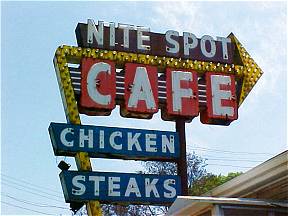 |
|||
|
Then there were the lonely signs. These
are the relics left when the area declined. Old neons and weathered ghost signs painted on
the sides of brick buildings speak to us of another time. Nichols Bar-B-Q stands like a
silent sentinel on guard in East St. Louis. What it is guarding now we'll never know for
it is surrounded by a weed choked vacant lot, the Bar-B-Q building long since razed. One one corner we saw a small store, boarded up and forlorn. C and T's Variety Ice Cream was painted on its side. This ghost sign brought images of a friendly neighborhood store, kids on their bikes with buffalo nickels in their pockets riding up to get a special Saturday afternoon treat on a hot summer's day. Between the lull in traffic along Route 66 muffled sounds of a radio playing the new Glen Miller hit song could be heard. The melodic sound caresses the kids and abruptly disappears as a truck drives by on its way to somewhere else, always somewhere else on Route 66. There's a lot of memories along these old streets in East St. Louis. |
|||
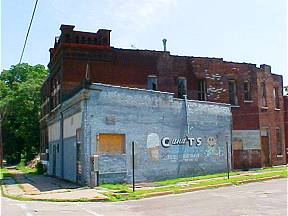 |
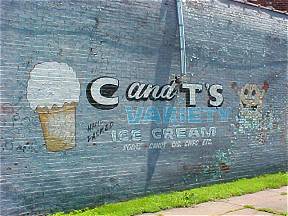 |
|||
East St. Louis and White Flight |
||||
| Today Interstate 55 roughly follows the path Route City 66 once took into St. Louis. Interstate 55 crosses the Mississippi River near the old MacArthur Bridge and enters St. Louis from East St. Louis. One word of caution though, East St. Louis is a depressed area of Route 66 that might not be appropriate for the casual Route 66er - especially at night. I think East St. Louis is one of the saddest sections to be found on Route 66 today. It illustrates the darker side of our American culture. Many have proclaimed that Route 66 was a "whites only road" and to some degree that is true. | ||||
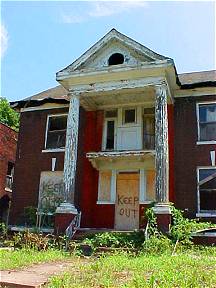 |
The time period in American history that Route 66 represents was fraught with discrimination. From the white displaced farmers during the Dust Bowl to the transient Gypsies, from Native Americans to Black Americans and all races, colors and creeds in between - all have felt some form of discrimination at one point in time or another. Non-white ethnic groups have much different memories of Route 66 in many cases. Though all ethnic groups used Route 66, some motels and cafes were closed to certain minority groups. Perhaps one of the saddest outcome of these times and this prejudice is a phenomena know as "White Flight." East St. Louis could be a case study for the effects of this unfortunate migration. East St. Louis began its decline when Route 66 faded as an economic force due to the new Interstates reroute the flow of traffic. Compounding this decline, the opening of once predominantly white neighborhoods to other ethnic groups due to the Civil Rights Movement of the 1960s cause a mass migration of affluent whites away from these old neighborhoods. | |||
| The whites took their money with them when they left and the economic base for these neighborhoods collapsed. Poverty, crime, anger and a feeling of hopelessness settled into the once prosperous neighborhoods. This is the "White Flight" phenomenon that has turned East St. Louis into what it is today. But there is a lot of faded glory to be seen along the Mother Road here. One can only imagine what this place was like in the early days of Route 66. One hundred years ago this was a prosperous place to be. If you look closely at the now ruined buildings and homes in East St. Louis you will begin to understand what fear and prejudice can do. | 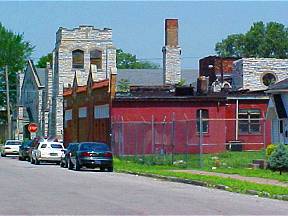 |
|||
| Like I said, it was a quiet Sunday morning when Emily Priddy and Ron Warnick of the Friends of the Mother Road gave me my tour of East St. Louis and City 66. The streets were quiet as we went in search of the Mother Road. Even with the apparent peacefulness of these old neighborhoods we passed through, every time I got out of the car to take a photograph Emily would assure me that she would watch my back. Rather intimidating for this small town country boy I thought. Unfortunately, East St. Louis may be too rough for the casual Route 66 explorer, but its history is an important part of the Route 66 story and that story is really a part of the larger American story, for better or for worse. | ||||
©2001 -2004 GRandall Web Design Service